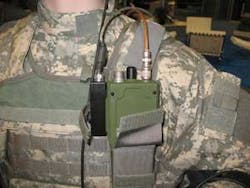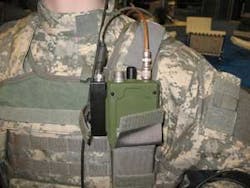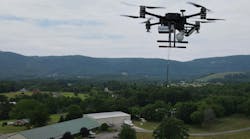By John McHale
SAN DIEGO–Engineers at General Dynamics C4 Systems in Scottsdale, Ariz., say the Joint Tactical Radio System’s Handheld, Manpack, and Small Form Fit (HMS) radios are on track for deployment at the beginning of the next decade.
The schedule has first production in 2009 with delivery in 2010, says Chris Brady, president of Assured Communications Systems for General Dynamics C4 Systems. Brady made his comments at the General Dynamics booth at the MILCOM conference and exhibition in San Diego last month.
Right now “we’ve got 40 Rifleman handheld radios in evaluation with a U.S. Army Task Force at Ft. Bliss, Texas, taking place between now and December,” Brady notes. “We are very excited about this demonstration. It’s a big network through a small radio.
“The Rifleman Radio is a body-worn single unit radio that General Dynamics C4 Systems initially demonstrated on the Army’s Land Warrior program,” Brady says. Now it is part of the follow-up to Land Warrior called the Ground Soldier Ensemble, he adds. The Rifleman also has additional radio controls and its own power supply.
It uses the Soldier Radio Waveform, which has ad-hoc capability, Brady notes. A team can go into theater with “connectivity for voice, video, and data, as well as a position locator based on global positioning system (GPS) technology,” he continues.
“The primary feature of the SRW is that it can create a network on an ad-hoc basis,” Brady says. For example, if a soldier loses connectivity while in a cave, “he can reconnect via the other soldiers’ radios,” he explains. “The team lead will always have situational awareness through position location information.”
The two-Channel Manpack radio is Type 1 secured and will have a variety of new form factors, Brady says. The Mobile User Objective System (MUOS) waveform was added to this radio, he notes. It also uses SRW and SINGCARS or Single Channel Ground and Airborne Radio System. The Manpack radio also has a 20-kilometer range that is reached through an amplifier, Brady says.




